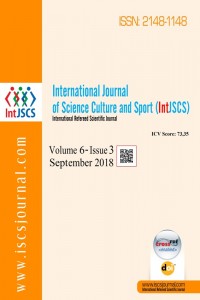Abstract
References
- Bus drivers: Occupational stress and stress prevention. (1996). Retrieved from http://www.ilo.org/public/english/protection/condtrav/pdf/wc-mk-96.pdf
- Burlayev Yu V (2010). Bezopasnost zhyznedeyatelnosti na transporte.[Transport Safety] Moscow: Academiya
- Gradusov VA, Marchenkov МК (2005). Systema otsenki specialnoy podgotovki sportsmenov avtogonshchikov, pilotov formuly „К” (avtosport-carting). [Evaluation System of Training for Formula “K” Pilots] Slobozhanskiy naukovo-sportyvnyy visnyk, vyp. 8, 139–141.
- Keller VS, Radygina КI (1980). Issledovaniya sorevnovatelnyh nagruzok gornolyzhnikov. [Investigaton of Alpine Skiers’ Competitive loadings] Kyiv.
- Kuznetcov АА (2007). Optimizatciya psihofizicheskoy podgotovlennosti avtogonshchikov rally vysokoy kvalifikatsii. [Optimizaton of Top Rally Pilots’ psycho-physical Preparedness] Russian State University of Physical Culture, Sport and Tourism, Moscow.
- Ospinnikova К (2003). Zashchiti sebya sam. [Defence yourself] Avtosport, 4, 37–40.
- Ryabchinsky AI (2001). Passive safety of Trucks (вiomechanics RTA with trucks). European Vehicle Passive Safety, Network : Seminar, Workshop, 185–107.
- Rybak O (2002). Udoskonalenie aktyvnego bezpieczenstwa zawodow, jako czynnik dalszego rozwoju sportu samochodowego. Wychowanie fizyczne i sport, T. XLVI, сz. 1, 321.
- Rybak О (2005). Zapobihannya pereventazhennyam na orhanizm sportsmen v avtomobilnomu sporti.[Prevention of Overloadings in Autosport] Moloda Sportyvna nauka Ukrainy, vyp. 9, т. 1, 153–164.
- Rybak О (2005). Funktcionalna pidhotovka avtohonshchykiv zasobamy aerobiky. [Functonal Training of Pilots by aerobics] Slobozhanskiy naukovo-sportyvnyy visnyk, vyp. 8, 144–147.
- Rybak О (2013). Bezpeka zmahalnoi diyalnosti v avtomobilnomu sporti. [Safety of Competitive Activity in Autosport] Lviv : LDUFK.
- Singurindi EG (1982). Avtomobilnuy sport. [Automobile Sport] Moscow: DOSAAF.
- Szczepaniak R, Szczepaniak S (2015). Obciążenia psychofizyczne kierowcy a bezpieczeństwo transportu drogowego. Logistyka, 4, 5943–5949.
- Trofimetc Yu I (1977). Tehnika motokrossa. [Motocross Technique] Kyiv: Zdorovya.
- Trofimetc Yu I (1990). Motokross. Podgotovka gonshchikov.Moscow: Patriot.
- Zanko NG, Retnev VМ (2004). Medyko-biolohicheskiye osnovy bezopasnosti zhyznedeyatelnosti. [Medical and Biological Grounds for Life Safety] Moscow: Academiya
- Zudin VN (2004). Chastota serdechnyh sokrashcheniy kak instrument opredeleniya sorevnovatelnyh I trenirovochnyh nagruzok v avto I motosporte. [Heart Rate as the Mean of Measurement of Competitive and Training Loadings in Auto and Motor Sport] Teoriya I praktika prikladnyh I ekstremalnyh vidov sporta, 2, 8.
Prevention of Negative Effects of Nervous and Psychic Stress on the Driver’s Cardio-Respiratory System
Abstract
Keywords
nervous and psychic stress a driver cardio-respiratory system negative influence prevention
References
- Bus drivers: Occupational stress and stress prevention. (1996). Retrieved from http://www.ilo.org/public/english/protection/condtrav/pdf/wc-mk-96.pdf
- Burlayev Yu V (2010). Bezopasnost zhyznedeyatelnosti na transporte.[Transport Safety] Moscow: Academiya
- Gradusov VA, Marchenkov МК (2005). Systema otsenki specialnoy podgotovki sportsmenov avtogonshchikov, pilotov formuly „К” (avtosport-carting). [Evaluation System of Training for Formula “K” Pilots] Slobozhanskiy naukovo-sportyvnyy visnyk, vyp. 8, 139–141.
- Keller VS, Radygina КI (1980). Issledovaniya sorevnovatelnyh nagruzok gornolyzhnikov. [Investigaton of Alpine Skiers’ Competitive loadings] Kyiv.
- Kuznetcov АА (2007). Optimizatciya psihofizicheskoy podgotovlennosti avtogonshchikov rally vysokoy kvalifikatsii. [Optimizaton of Top Rally Pilots’ psycho-physical Preparedness] Russian State University of Physical Culture, Sport and Tourism, Moscow.
- Ospinnikova К (2003). Zashchiti sebya sam. [Defence yourself] Avtosport, 4, 37–40.
- Ryabchinsky AI (2001). Passive safety of Trucks (вiomechanics RTA with trucks). European Vehicle Passive Safety, Network : Seminar, Workshop, 185–107.
- Rybak O (2002). Udoskonalenie aktyvnego bezpieczenstwa zawodow, jako czynnik dalszego rozwoju sportu samochodowego. Wychowanie fizyczne i sport, T. XLVI, сz. 1, 321.
- Rybak О (2005). Zapobihannya pereventazhennyam na orhanizm sportsmen v avtomobilnomu sporti.[Prevention of Overloadings in Autosport] Moloda Sportyvna nauka Ukrainy, vyp. 9, т. 1, 153–164.
- Rybak О (2005). Funktcionalna pidhotovka avtohonshchykiv zasobamy aerobiky. [Functonal Training of Pilots by aerobics] Slobozhanskiy naukovo-sportyvnyy visnyk, vyp. 8, 144–147.
- Rybak О (2013). Bezpeka zmahalnoi diyalnosti v avtomobilnomu sporti. [Safety of Competitive Activity in Autosport] Lviv : LDUFK.
- Singurindi EG (1982). Avtomobilnuy sport. [Automobile Sport] Moscow: DOSAAF.
- Szczepaniak R, Szczepaniak S (2015). Obciążenia psychofizyczne kierowcy a bezpieczeństwo transportu drogowego. Logistyka, 4, 5943–5949.
- Trofimetc Yu I (1977). Tehnika motokrossa. [Motocross Technique] Kyiv: Zdorovya.
- Trofimetc Yu I (1990). Motokross. Podgotovka gonshchikov.Moscow: Patriot.
- Zanko NG, Retnev VМ (2004). Medyko-biolohicheskiye osnovy bezopasnosti zhyznedeyatelnosti. [Medical and Biological Grounds for Life Safety] Moscow: Academiya
- Zudin VN (2004). Chastota serdechnyh sokrashcheniy kak instrument opredeleniya sorevnovatelnyh I trenirovochnyh nagruzok v avto I motosporte. [Heart Rate as the Mean of Measurement of Competitive and Training Loadings in Auto and Motor Sport] Teoriya I praktika prikladnyh I ekstremalnyh vidov sporta, 2, 8.
Details
| Primary Language | English |
|---|---|
| Journal Section | Articles |
| Authors | |
| Publication Date | September 30, 2018 |
| Published in Issue | Year 2018 Volume: 6 Issue: 3 |

